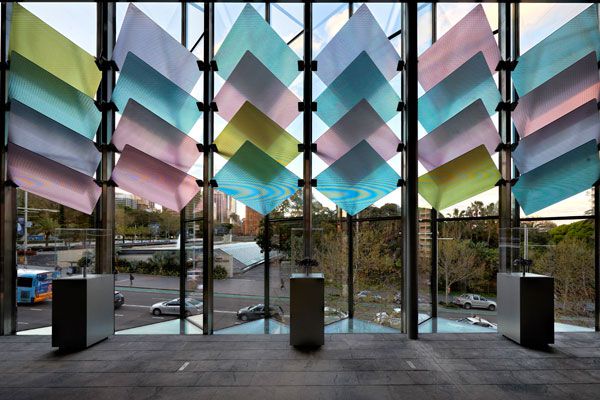The Australian Museum has officially opened its new ‘front door’ to the world – the Neeson Murcutt and Joseph Grech-designed ‘Crystal Hall’, a glass pleated, carbon neutral pavilion featuring leading environmental technology.

September 30th, 2015
Designed to float transparently off the Museum’s sandstone northern façade, the Crystal Hall Pavilion provides a new main entrance servicing the building’s repositioned address, 1 William Street, Sydney.
Key architectural features of the crystalline hall include a defining glass-pleated north-facing façade, a slim-line ‘crystalline and skeletal’ form helps to reflect the Museum’s natural history focus and an Australian-first environmental management system addressing solar glare and heat.
Architect Rachel Neeson says Crystal Hall responds directly to the Museum’s brief for an elevated, highly transparent, elegant glass entry pavilion on a north-facing elevation overlooking William Street. As importantly, she said, it needed to respond appropriately to the exposed north-facing site and climatic conditions, with Neeson Murcutt and Joseph Grech Architects (Architects in Association) working closely with consulting engineers Arup to develop innovative solutions to optimise the building’s structural and environmental performance.
“It was important to come up with a solution that kept the architectural intervention as light and transparent as possible, and played off the ideas of geology, skeletons and natural forms. We did a lot of work, analysis, research and testing to develop for the first time the glass diamonds in the crystal hall,” says Arup Principal (Building Physics) Haico Schepers.
The bespoke glass-pleated, zig-zagged crystalline screen of the north-facing façade balances transparency through to the existing heritage building with leading environmental management. The state-of-the-art, triple-low-E, double-glazed façade selectively allows daylight in while reflecting short wave and infrared heat. Extended vertically and horizontally beyond the floorplate, the screen features 24 stainless steel-framed, 8.5 metre high panels formed into 12 dramatic vertical ‘pleats’.
Designed as a simple, open plan elongated space, 20 metres by eight metres, with a 5.5 metre high ceiling and ‘feathered’ northern edge, a slim-line ‘crystalline and skeletal’ form helps to reflect the Museum’s natural history focus. Operable glass walls frame the southern elevation and heritage façade while providing ventilation. Zinc cladding wraps the eastern elevation externally, with a wall of A/V screens internally for functions and showcasing exhibitions, while providing a sense of shelter. Operable glass walls and doors frame the entry and west.
The Crystal Hall features an Australian-first environmental management system addressing solar glare and heat. Developed for the first time by Neeson Murcutt Architects, Joseph Grech Architects and engineers Arup collaboratively to manage solar glare and heat in a uniquely innovative way. Forty-eight unique crystalline diamond-shaped, coloured glass ‘blades’ are positioned internally along the northern façade, angled and pivot-hung in each pleat (four per pleat) to refract and diffuse light, manage solar glare and capture heat, allowing it to be vented up and out through the ceiling. Six different ‘soft colours’ – shades of mauve, blue, pink and yellow – are used across the façade, with the system expected to allow natural ventilation of the north-facing glass hall for most of the year.
“This is a stunning, highly visible new space for the Australian Museum and City of Sydney, one that allows us to realise and complete the critical first stage of our ongoing transformation,” Kim McKay AO, Executive Director and CEO of the Australian Museum, says. “Crystal Hall helps achieve the AM’s plans in a sophisticated way. It allows us to visibly extend a welcoming hand to visitors while enlivening and connecting us to William Street. As importantly, it represents not just a new reception area for the AM, but an exhibition space, an out-of-hours venue, and a new gathering point for the public, while liberating exhibition space internally.”
The Crystal Hall is now open to the public.
Australian Museum
australianmuseum.net.au
INDESIGN is on instagram
Follow @indesignlive
A searchable and comprehensive guide for specifying leading products and their suppliers
Keep up to date with the latest and greatest from our industry BFF's!

Gaggenau’s understated appliance fuses a carefully calibrated aesthetic of deliberate subtraction with an intuitive dynamism of culinary fluidity, unveiling a delightfully unrestricted spectrum of high-performing creativity.

A longstanding partnership turns a historic city into a hub for emerging talent

Designed by CHT Architects with Sora Interiors, the newly completed St James Park Residences in Hawthorn, offer Melbournites an urban, à la mode alternative to the outlived quarter acre dream.
The London Festival of Architecture takes place from 19 June to 4 July 2010 and will be a city-wide celebration of architecture in the capital.
Got a big green idea? Or a sustainable business strategy? The Big Green Idea is a new funding initiative from the British Council designed to help put eco-visionary ideas into action. Offering five grants of $10,000 to help kick-start projects, they are calling for submission ideas for addressing some of our biggest sustainability challenges while […]
The internet never sleeps! Here's the stuff you might have missed

PFAS-Free, height-adjustable office desks and workstations deliver a healthier, more sustainable workspace.

Designed by artist Abdul Abdullah, the porcelain façade for this Melbourne train station has been executed with custom-printed Fiandre DYS panels.

With the new Tangram collection for Cesar, García Cumini introduces a timeless system of delightfully winding volumes, artfully concealed functionality and sculptural compositions that move beyond rigid angularity to redefine the social heart of the home with intuitive flow.